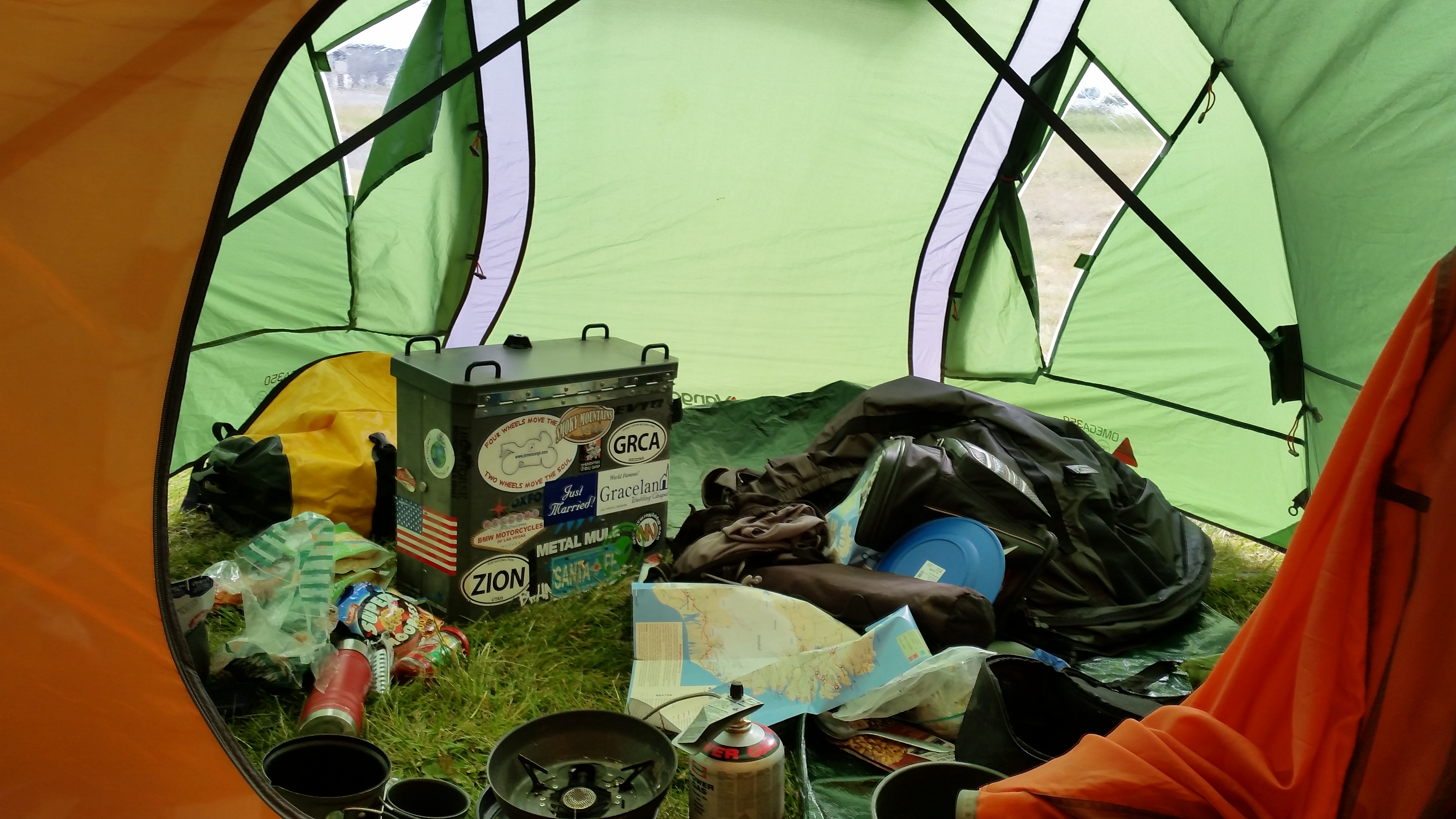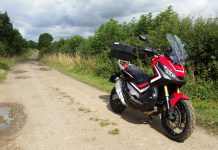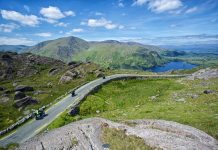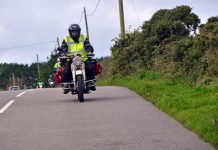Graeme Hoose has been pitching tent for over 50 years. Here he gives advice on putting together a basic camping kit…
“I started camping aged nine as a Cub and carried on for several years with the Scouts. After that I spent some time paying back into them for all the experience and training they gave me, acting as leader on several expeditions.
Since then I have spent nearly 50 years strapping camping gear on my back; push bikes and motorbikes from 100 to 1200cc, taking personal trips all over the UK and Europe, from Iceland to Bulgaria.
Tents
If you are inexperienced at camping or have never done it with a motorcycle before then there are a few simple tips that will ensure you stay warm, dry and get a good night’s sleep, ready for the next day’s adventure.
Tents to ignore, unless you are spending big bucks, are any budget single skin tent (as they are for fair weather only as they get cold and are prone to condensation in our climate), and usually any advertised as hiking tents. Instead, always look for a tent with a breathable inner and waterproof outer or fly. Also, ideally with enough headroom to sit up inside to at least get some of your bike kit on if the weather is wet outside.
Tent sizing is fairly easy for motorcycle touring; number of people using it plus one. Hiking tent sizing is however based on one person plus a rucksack, not a helmet and riding gear. Also, until you have built up some experience in camping then you might be advised to stay away from tarp and hammock camping; its a skill that takes time to acquire.
Most suppliers and manufacturers now split their smaller and lightweight tents into Hiking and Adventure tents… and you are heading off onto an adventure.
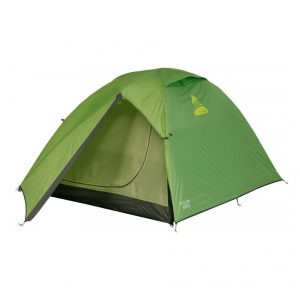
The two main types to consider are dome tents and tunnel tents. Dome tents (Eurohike Avon) and their close relatives; semi geodesics (like the Vango Halo), are useful for any expedition with numerous overnight stops and early starts as they are quick to pitch (erect) and hike (take down). They are also self-supporting (also known as free standing) and can be anchored with your kit in an emergency. Look for one with a porch area. This is a must have as it will give you somewhere to protect the entrance to the inner in bad weather and also offer somewhere to store wet gear and even have a brew.
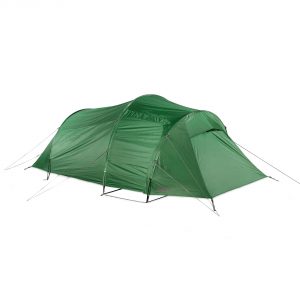
Tunnel tents such as the Vango Omega give plenty of porch space and head room but are not as quick to pitch and need pegging out to take shape, which is something to consider if you are heading off to sandy climates where it might be difficult to get pegs to stay put, or on locations with firm or rocky ground, where it might be difficult to get pegs in at all.
Most tents in the UK are pitched fly first (the outer later) or with both parts together, as this benefits having a dry sleeping compartment in our less than sunny climate. If you head off to the south of Europe then consider a tent that can be pitched inner first as this will be cooler, especially if it has mesh doors, allowing air in and the insects out.
Pitching tents has some basic rules as well. Always check for stones and sharp objects as these can easily pierce the ground sheet. A foot print or second ground sheet (tarp) is useful to take with you, especially if you’re likely to be camping on rough ground. When pitching, try and look for smooth ground with as few hummocks and clumps of weeds as possible, and keep above the lowest point of a field where the surface water will drain.
If you have to sleep on a slope make sure your head points uphill. Stay away from under trees, as roots will often make the ground uneven, branches can drop and trees get hit more often by lightning than any other object. Also, when it rains the ground stays dry…ish, but beneath a tree, when the dripping starts, it’s like water torture and soaks the tent.
Lastly, tents advertised as ‘Festival Specials’ should be ignored as they get left behind for a reason. Instead, look at a well known supplier like Go Outdoors, Cotswold Outdoors and Blacks/Millets and dedicated local camping shops. Also look for local camping exhibitions where companies will often sell off the display models at huge discount, as long as you turn up on the last day and take the tent down yourself. Brands to look for are Eurohike, Vango, Coleman and Outwell.
Sleeping Bags
Now its time to cover keeping warm. Sleeping bags come in many shapes and forms and two major filling types; Polyester Hollow-fibre and Down. Each has it pros and cons but the proven best bag shape for most is the one described as the mummy bag. Shaped like an Egyptian mummy with a hood to keep in heat and prevent draughts from the top allowing heat to escape. Down is the warmest and lightest and has the smallest pack size, but it’s also expensive, and should only be bought from ethical suppliers who use the Responsible Down Standard. It’s only major downside is that it can lose effectiveness if it gets wet, so if you want to go down this route look for hydrophilic down. You will also need specialist cleaners when comes to freshening it up.
Hollow fibre works the same way as down but is more bulky when packed for the same level of stuffing. The good thing about it is that it keeps working even if it gets wet, and is easier to clean.
Both types of filling work the same way in keeping a layer of warm air contained by insulation. You’re looking for a bag that is a snug but not a tight fit. Get down and dirty in the shop, make sure there are no tight areas which will reduce insulation and when you are fully inside your feet are not tight against the bottom. Actually, a good gap can be handy for placing clothes in to keep them warm on a cold night. Also, make sure you can use the zip fully in the bag. Most bags have a two-way zip that can be left or right handed to allow bags to be connected and for ventilation.
Most bags will either have a season or comfort temperature rating (max and min temp range). Unfortunately there is no industry standard for this, so rule of thumb is to use a two season bag only at the height of summer and a three season bag for the rest of the year. By using a liner you can add a few degrees to the suggested comfort rating of any bag and help reduce the need for cleaning.
Using a silk liner adds about 5C and can be used to sleep in on top of a three season bag in a summer crossing of Europe, and inside the bag when you reach the Alps and are camping on a trail. Brands to look out for include Snugpak, Mammut, Vango and Rab.
Sleeping Mats
Another essential item is a good sleeping mat. They work by insulating and padding your sleeping area. Bigger is not always better and the perennial rubberised canvas guest bed air mattress is the worst you can have. Lots of padding but works as an effective heat pump on cold nights, transferring your heat into the ground. They’re also heavy and bulky and require a pump to inflate. They therefore rob you of valuable space and are prone to punctures.
The most basic alternative is a closed cell foam mat, which is often too big to pack but will work when wet and never needs a puncture repair. Then comes the reed type manually inflated air-bed; easy to inflate by mouth and the use of reeds prevents a total deflation. Small pack size and low weight.

The most luxurious though are the self inflating mats. Once again it’s a case of the more money you pay the smaller the pack size and more effective the insulation and comfort. However you can take a tip from the lightweight cycle campers and only use a three quarter one to stop cold spots and pressure points on the shoulders and hips. Brands to look for are Therm-a-Rest, Alpkit and Exped.

One last thing to consider are the cot beds that pack up small and are relatively straight-forward to assemble, although some of them – especially the cheap ones from eBay – are a bit of a faff. In cold weather they can prove a bit chilly due to the air circulating under the cot, which can be improved by laying an inflatable mat on top, and on sloping group they aren’t the most stable. For some people though, they are much more comfortable than a mat.
Stoves
In Europe it’s often just as cheap to depend mainly on café’s and trucks stops for good cheap food and drinks, as is it is to cook for yourself. Cooking equipment, unless you invest heavily on specialised kit, can take up a lot of space, but for an early start or a late finish being able to get a quick meal and a brew together can be seen as essential.
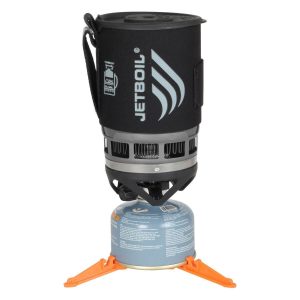
First thing is the stove. Forget spirit and hexamine, life is too short to wait for water to boil using them. Instead look at gas or multi fuel stoves. Even the universal standard of the Trangia stove now has gas or multi fuel conversions available. Gas is universally available through Europe but often only the ubiquitous pierced Camping Gaz blue cans. Not something I would recommend as the stoves then become bulky to pack if all the gas isn’t used and the gas they contain is often slow burning at altitude and in the cold. However adaptors are available for the stoves using screw in canisters, which are available with a propane and butane mix which works better in the cold and at altitude.

The other option is the multi-fuel stove which uses a pressurised bottle to ensure an even burn. You can fill this from your bike, but with most stoves it has the downside of blocking jets with soot, so keep the cleaning kit handy. Trangia stove systems are a bit pricey but last a long time and have the advantage of having all the pans and burner packed into a compact stacked system that gives enough to get a brew on and do a simple pasta and sauce dish. For even more simplicity look at the Jetboil Zip system, simple and effective for boiling a litre of water in the shortest time possible. Great for a brew and getting a dried meal heated for a late finish, or even for doing a basic purification of water for your day’s ride.
Plates and cutlery are not strictly essential as you will have at least a Swiss army knife or similar packed, and the Spork covers all other bases. But always pack a spill proof insulated mug. They come in handy for more than just a cuppa. The only other extra accessory, apart from a small stackable set of pans, I would recommend for a standalone stove is a fold up windshield. A steady flame cooks the quickest. And a tin opener just in case the canned food you buy isn’t ring-pull. Brands to look for MSR, Trangia, Coleman, Optimus and Jetboil.’


